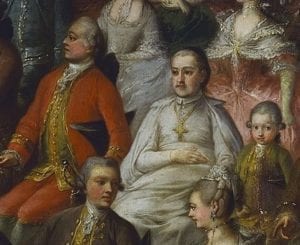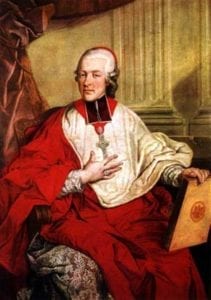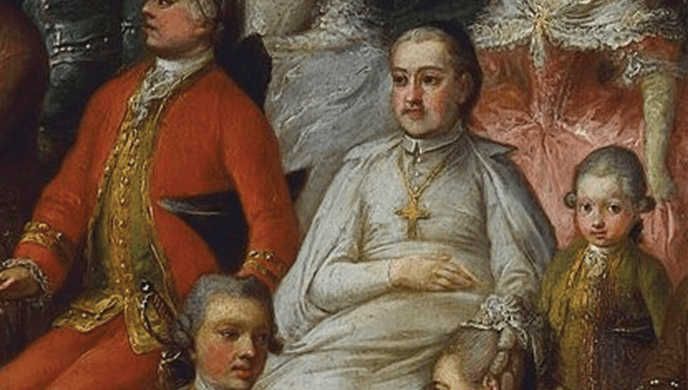MOZART IN SALZBURG: A TALE OF TWO PRINCE-ARCHBISHOPS
By Bruce Lamott

Modern day Salzburg, Austria
Mozart’s love-hate relationship with Salzburg, his picturesque birthplace, stemmed largely from a regime change that was pivotal in his musical career. Our PBO season opens in October with “Mozart’s Magnified,” three magnificent sacred works he wrote while a Salzburg resident: the “Coronation” Mass, Exsultate jubilate (concluding with his famous “Alleluia”), and the rarely performed Lorettan Litany in D Major (Litaniae Lauretanae BVM).
The independent city-state of Salzburg was ruled by a succession of “prince-archbishops,” whose extravagance was better known than their piety. Their fortress and palace looms on the cliffs above the magnificent Baroque cathedral, as well as two ornate ride-in watering fountains for their horses. Wolfgang was born three years into the rule Archbishop Sigismund Christoph von Schrattenbach (ruled 1753-1771), described by Mozart biographer Volkmar Braunbehrens as “a crotchety, capricious bigot…in whom patriarchal affability was not accompanied by any particular intelligence.” But no matter: he loved the Mozarts.

Theatre performance held on occasion of the wedding of Joseph II of Austria with Maria Isabella of Parma, October 6, 1760. Detail highlighting young Wolfgang Amadeus Mozart between his father Johann Mozart and Prince Sigismund-vescoco Schrattenbach
In a painting documenting the hundreds of luminaries in Vienna who attended the wedding of the future Emperor Joseph II in 1760, four-year-old Wolfgang is shown with his father Leopold and Archbishop Schrattenbach. The archbishop realized how Leopold, his Vice-Kapellmeister and author of a widely circulated treatise on violin playing, and his musically prodigious children, Wolfgang and Nannerl, could enhance Salzburg’s cultural status with a three-year road-show grand tour of Europe. Nine months after they came home, father and son set out to the courts of Italy, where–among other achievements–Wolfgang was knighted by the Pope, admitted to the prestigious Accademia Philharmonica in Bologna, and composed and conducted his first opera seria (serious opera) for the Royall Ducal Theater in Milan. However, the day after they returned to Salzburg, Archbishop Schrattenbach dies.
Enter Archbishop Hieronymus von Colloredo (ruled 1772-1803), a Viennese blue-blood and Joseph II enlightened despot wannabe. The Wolfgang he meets is no longer a cherubic prodigy but a cocky and urbane teenager. We can also be certain that it didn’t take long for the new prince-archbishop to learn from Leopold’s disgruntled musical colleagues that out of the previous ten years, he had been given leaves totalling six years and nine months!

Archbishop Hieronymus von Colloredo
Colloredo was an accomplished musician and recognized talent when he saw it. He gave Wolfgang something he’d never had: a job with a salary. However, he expected the Mozarts to fulfill their contracted duties, Leopold as vice-kapellmeister and Wolfgang as concertmaster (until 1777) and court organist (from 1779). The following nine years tested the patience both of the enlightened but despotic archbishop and the increasingly dissatisfied young Turk who felt both disrespected and confined. The unpopular Colloredo imposed Enlightenment values of austerity and simplicity on a reluctant Salzburg, including limitations on the length of church music–certainly unwelcome to the composer of such magnificently “operatic” church music as the Exsultate jubilate.
When Wolfgang finally jumps ship from the archbishop’s retinue while in Vienna in 1781, he reports that in a confrontation with Colloredo’s chamberlain, he was called “clown” and “knave,” and was tossed out of the room “with a kick in the ass.” “But,” he adds sarcastically, “I am forgetting that this was probably done by order of our worthy prince archbishop.”
Experience Mozart’s sacred chorale works the way he intended them to be heard when Philharmonia Baroque Orchestra & Chorale performs Exsultate, jubilate, Litaniae Lauretanae and the “Coronation Mass” in October with exquisite soprano Camille Ortiz.






